Back in May, we touched on the purpose of investor pitch decks. and what makes a good pitch deck in general. We got a lot of questions about the actual components of a good deck. So today’s blog is specifically about what sections to include in the invention maker’s pitch deck.
For this task, we’re taking a look at ChaiEasy’s deck again, but step-by-step this time. You can view and download it from their FrontFundr page here. Their easy-to-follow structure and clean layout mirror the popular deck Airbnb used to pitch to VCs. Indeed the Airbnb pitch deck is considered to be the standard amongst the entrepreneurial and business communities for its spectacularly clear and concise slides.
Below are the sections you should include in your pitch deck. What you’ll notice is many of these sections are derived from the Business Model Canvas.
(It’s also why we recommend starting with that canvas before anything else!)
- Branded Title Page
- Problem Worth Solving
- The Solution
- Competitive Landscape
- Founding Team
- Business Model
- Market Validation
- The Ask
- Marketing Plan
It’s worth noting that you don’t have to do it in this order. You’re the one pitching your idea, so do what fits your narrative. Word of advice, though: you’ll probably want to put your solution near the top if you want to keep your audience engaged.
Before we get started, be sure to download their version of the invention maker’s pitch deck from their FrontFundr page!
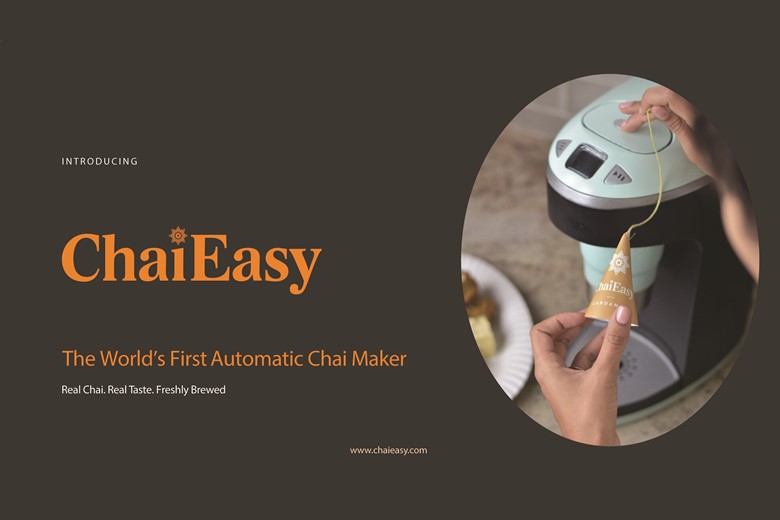
1. Branded Title Page | Slide 01
Why it Works:
Some of you might not think this page is important, but there’s some great information hidden in here that’s easily overlooked by the new invention makers creating their first pitch deck. Obviously, you want the name of your product or brand and/or product up there. But there are also small touches like introducing orange elements to indicate that it’s the brand’s main color. There’s also a slogan that tells the audience exactly what the product does. The inclusion of a real website at the bottom adds a professional touch.

2. Problem Worth Solving | Slides 02 – 05
Why it Works:
Every great idea starts with a problem worth solving. ChaiEasy sets this up nicely early on in its pitch deck by foreshadowing that it aims to simplify the complex process of making authentic chai. Samir and Amit outline the many steps required to make chai and the specific pain points that emerge from this process. They did a great job demonstrating this visually on Dragons’ Den to help the audience understand these problems in a relatable way.
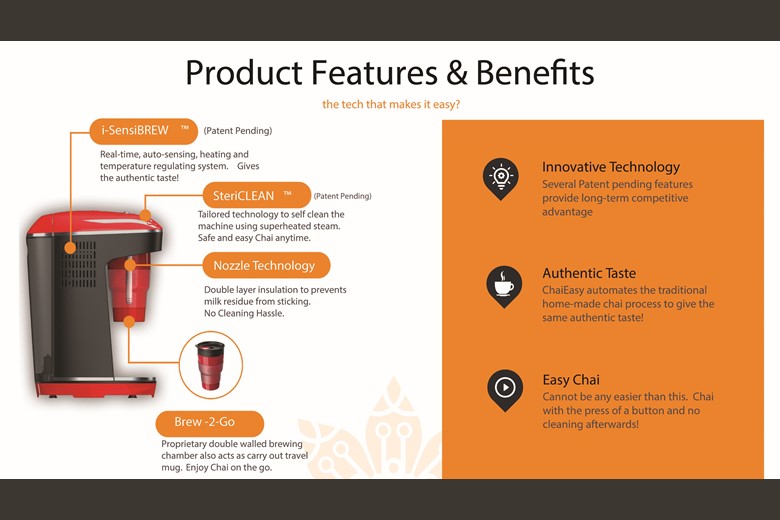
3. The Solution | Slides 06-07
Why it Works:
It’s a great mix of basic visual and brief text elements to make the solution easy to understand. Each of the features listed beside the image addresses the specific pain points indicated earlier in their pitch deck. Thus, it’s very clear how the product will deliver value to the customer, which is what the investor cares about.
The brewing system automatically regulates the temperature, so the user no longer needs to worry about overboiling. When taking into consideration the Nespresso-like chai pods, the entire preparation process is cut down from 20 minutes to single digits. The convenience of their self-cleaning technology for the nozzle and machine ensures the ChaiEasy is safe to use immediately.
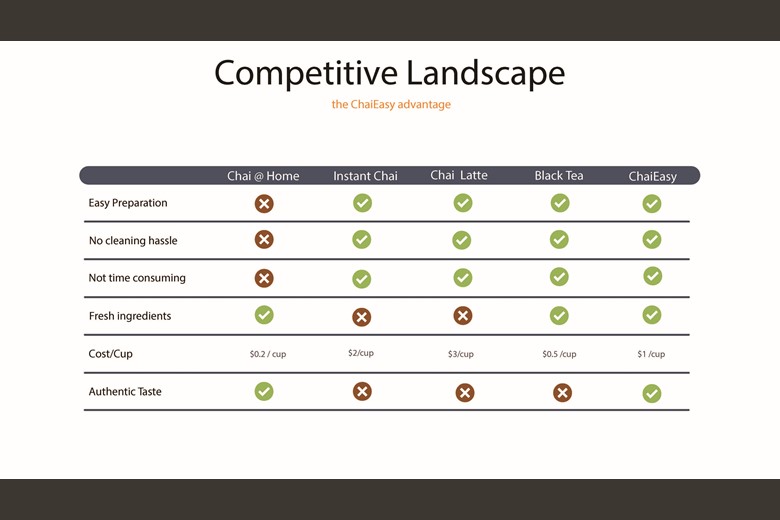
4. Competitive Landscape | Slide 08
Why it Works:
Charts are a simple way to help the reader visualize a ton of information simultaneously. On this page of the pitch deck, ChaiEasy reintroduces the competitors from the previous slides. I’d like to draw your attention to the Cost/Cup row. It’s my favourite part of this slide as it shows how ChaiEasy is not only a better-tasting option but also a generally more affordable option. And trust us, our
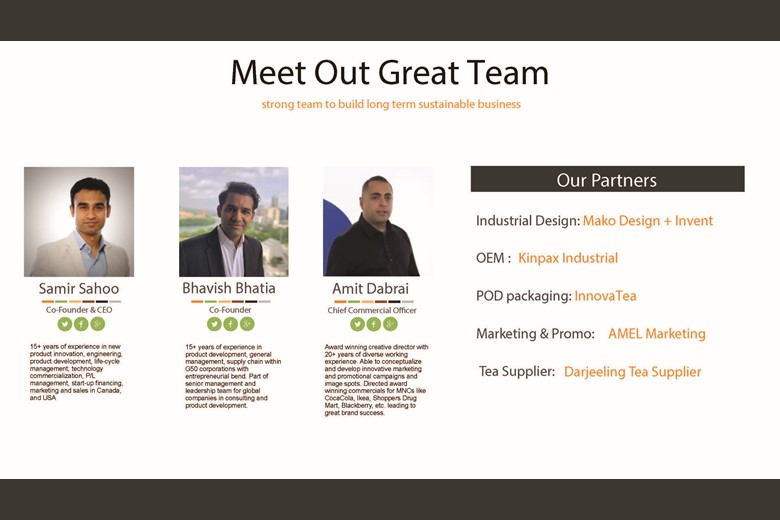
5. Founding Team | Slide 09
Why it Works:
Because they mention MAKO Design on the right of this slide in this pitch deck. Just kidding, it’s because they have the classic hipster, hustler, hacker trio. In the descriptions, they focus heavily on experience over academics. Samir is the hacker with 15+ years in product development and engineering. Bhavish is the hustler with extensive experience in supply and general management. Amit, the hipster, rounds out this group with his whopping 20+ years of experience in marketing and advertising. In addition, he’s also worked with some huge household names, including Coca-Cola and Ikea.
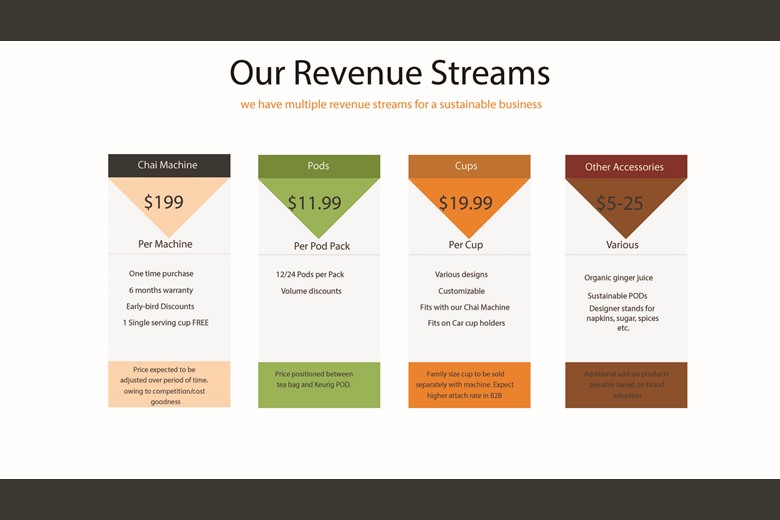
6. Business Model | Slides 10-11
Why it Works:
Specifically, on the Revenue Stream page of this pitch deck, they did a great job highlighting how ChaiEasy aims to go beyond tea to open up a variety of revenue streams. Each of these streams provides further value for both consumers and businesses alike. For example, resellers, wholesalers, and distributors. will love the fact that portable cups are customizable and come in a variety of designs to match the customer’s style.

7. Market Validation: Slides 12-14
Why it Works:
Validate your idea. Prove that there’s a legitimate market for the product. That’s exactly what ChaiEasy did in these slides of this pitch deck. Starting with Customer Profiles on slide 12, they did a great job breaking down their customers as B2C or B2B based on research. Based on these profiles, they go on to list their target geographic markets and the general size of these markets. In the bottom left of slide 14 pictured above, ChaiEasy indicates to the reader that there is a sizable sum, the SOM (Service Obtainable Market) to be earned in this market space as well.
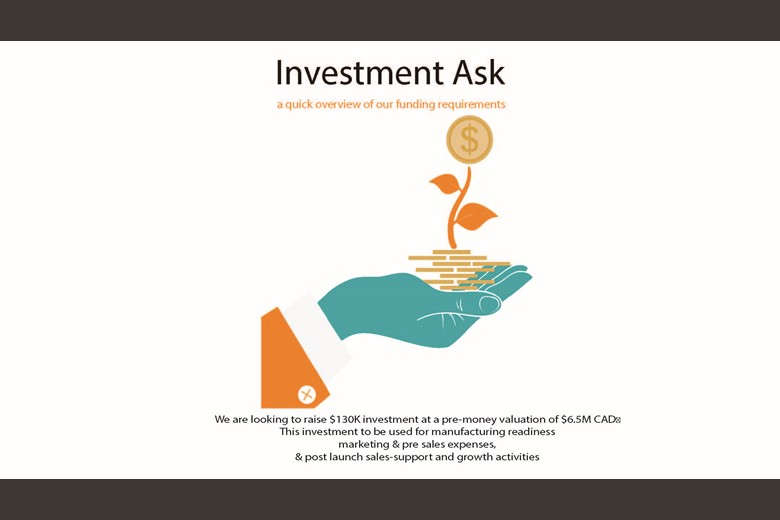
8. The Ask: Slide 15
Why it Works:
If you don’t ask, you don’t receive. This page in the pitch deck is fairly straightforward, as it tells the user what ChaiEasy plans to do with the funds. Be extra clear and to the point here. Investors want a definitive answer here. If they sense even just a hint of uncertainty, you can kiss goodbye to all the goodwill that you’ve built up to this point.
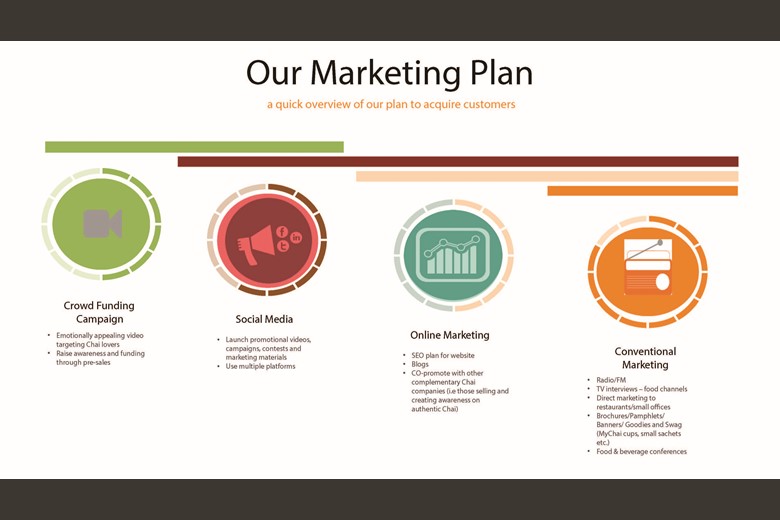
9. Marketing Plan: Slides 16-18
Why it Works:
They’re not just using one channel but multiple channels to communicate the value proposition to their target customers. Diversify and measure. Determine what channels you need to focus on and what channels are necessarily eating up your budget.
As you can tell, the great thing about creating an invention maker’s pitch deck to present to investors is that you don’t need to be a full-fledged designer! As long as you keep branding consistent and your information brief and salient, you have the beginnings of a winning formula.
If you have a great new invention idea and you’d like to learn more about this process, get in touch with MAKO today so we can get you set up on a call with our product strategist!
About: MAKO Design + Invent is the original firm providing world-class consumer product development services tailored to startups, small manufacturers, and inventors. Simply put, we are the leading one-stop-shop for developing your physical product from idea to store shelves, all in a high-quality, cost-effective, and timely manner. We operate as one powerhouse 30-person product design team spread across 4 offices to serve you (Austin, Miami, San Francisco, & Toronto*). We have full-stack in-house industrial design, mechanical engineering, electrical engineering, patent referral, prototyping, and manufacturing services. To assist our startup and inventor clients, in addition to above, we help with business strategy, product strategy, marketing, and sales/distribution for all consumer product categories. Also, our founder Kevin Mako hosts The Product Startup Podcast, the industry's leading hardware podcast. Check it out for tips, interviews, and best practices for hardware startups, inventors, and product developers. Click HERE to learn more about MAKO Design + Invent! *NOTE: Engineering services are provided exclusively by our USA-based engineering team







